| |
| |
Photographer,
Location, Date |
Larger images |
Comments |
|
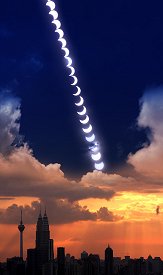
|
Gradient Lok,
Kuala Lumpur, Malaysia.
Jan. 26, 2009 |
#1,
#2, |
I took this
Solar Partial Eclipse in Kuala Lumpur Malaysia, with KLCC
& KL Tower as background, & montage in Photoshop to put
all into 1 photos, every interval of sun is 5 minutes. Pic
2 is showing 1 of the eclipse photo which behind the cloud.
Photo
details: Canon
40D, ISO 100, Sigma 80-400mm Apo Lens |
|
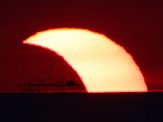
|
Dr
Armando Lee,
Mall of Asia seawall, Pasay City, Manila Bay, Philippines
Jan. 26, 2009 |
#1,
#2 |
"Crescent
Sunset" in Manila Bay, Philippines |
|
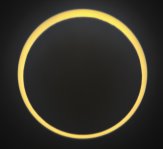
|
Miyagi
Takafumi,
Bandar Lampung Indonesia
Jan. 26, 2009 |
#1,
more |
The
evening sky gold ring Because it was to do the cloud being
which is thin, the soft ring as it hung a soft filter just
like could be seen.
Photo
details: Nikon
D700, the Takahashi astronomical telescope The 90 mm
caliber The focal length 1500mm 1/1600 seconds of exposure
ISO 200 Fuji film ND2.0+0.6 |
|
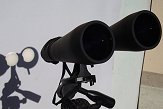
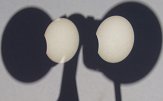
|
Ravindra
Aradhya,
Bangalore, Karnataka, India
Jan. 26, 2009 |
#1,
#2, #3 |
Nice
holiday treat for friends in Bangalore, Vivek, Ravi, Vijay,
Arvind Benaka, Pradeep jain enjoyed the Partial eclipse
through Binoculars...photos taken through Sony Cybershot
W150 |
|
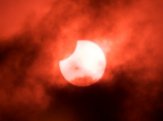
|
Shehal Joseph,
Nugegoda, Colombo District, Sri Lanka
Jan. 26, 2009 |
#1,
#2, more |
I observed a Partial Solar Eclipse this afternoon. Presented bellow are some pictures I took from my backyard. I used an Infrared (IR) Filter with a 500mm Opteka Mirror Lens, a 2x Barlow Lens, which gave me 1000mm on the mirror lens. I also used my EFS 55-250mm IS lens. The mirror lens is a cheap and light-weight alternative to a proper telescope. The afternoon Sun was very bright (because the Earth passed its Perihelion few days ago). Instead of using a small aperture I used the IR filter because it cuts off quite a bit of light.
|
more
images: from
Gary Corderley of Pretoria, South Africa; from
Roger Groom of Lake Leschenaultia, Western Australia; from
Ted Gonzaga of Iloilo City, Philippines; from
Prof. K. H. Raveesha of Bangalore, India; from
Azrael Coladilla of Bacoor, Cavite Philippines;
|
|